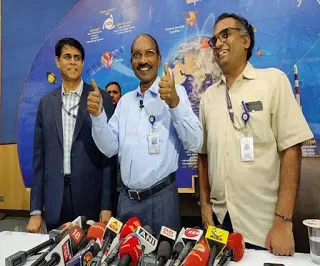What is ISRO
ISRO is the national space agency of the Republic of India, headquartered in Bengaluru.India decided to go to space when Indian National Committee for Space Research (INCOSPAR) was set up by the Government of India in 1962. With the visionary Dr. Vikram Sarabhai at its helm, INCOSPAR set up the Thumba Equatorial Rocket Launching Station (TERLS) in Thiruvananthapuram for upper atmospheric research.
It is one of six government space agencies in the world that possess full launch capabilities, deploy cryogenic engines, launch extraterrestrial missions and operate large fleets of artificial satellites.
What is the full form of ISRO
Indian Space Research Organisationfull form of isro in Hindi
Bhāratīya Antrikṣ Anusandhān SaṅgaṭhanWho is the father of the Indian space program
Vikram Ambalal Sarabhai or Vikram Sarabhai (12 August 1919 – 30 December 1971) was an Indian physicist and astronomer who initiated space research and helped develop nuclear power in India. He was honored with Padma Bhushan in 1966 and the Padma Vibhushan (posthumously) in 1972. He is internationally regarded as the Father of the Indian Space Program.Dr. Sarabhai started a project for the fabrication and launch of an Indian Satellite. As a result, the first Indian satellite, Aryabhata, was put in orbit in 1975 from a Russian Cosmodrome.
Dr. Sarabhai was very interested in science education and founded a Community Science Centre at Ahmedabad in 1966. Today, the Centre is called the Vikram A Sarabhai Community Science Centre.
Chairman ISRO
Dr. Kailasavadivoo Sivan (brought into the world on 14 April 1957) is an Indian space researcher who is the ebb and flow Secretary (Space) and ex-officio executive of the Indian Space Research Organization and Space Commission. He has recently filled in as the Director of the Vikram Sarabhai Space Center and the Liquid Propulsion Systems Center.ISRO achievements
ISRO was the world's first space agency to find water on the moon and insert a probe in orbit of Mars in its maiden attempt. It has the world's largest constellation of remote-sensing satellites and operates two satellite navigation systems namely GAGAN and NAVIC.What is ISRO spy case?
Here's the real story of Isro's' spy' case that rocked the nation in the 1990s.
ISRO spy case history
The espionage case, which had hit the headlines in 1994, pertained to allegations of transfer of certain confidential documents on India's space program to foreign countries by two scientists and four others, including two Maldivian women. thehindu
ISRO mission
The Indian Space Research Organisation has carried out 111 spacecraft missions, 79 launch missions and planned several missions including the Aditya, Gaganyaan, and MOM 2.
ISRO mission to moon
Chandrayaan-1
Chandrayaan-1 was India's first lunar probe. It was launched by the Indian Space Research Organisation on 22 October 2008 and operated until August 2009. The mission included a lunar orbiter and an impactor. The mission was a major boost to India's space program, as India researched and developed its own technology in order to explore the Moon. The vehicle was successfully inserted into lunar orbit on 8 November 2008.
Chandrayaan-2
Chandrayaan-2 was launched from the second launch pad at Satish Dhawan Space Centre on 22 July 2019 at 2.43 PM IST to the Moon by a Geosynchronous Satellite Launch Vehicle Mark III (GSLV Mk III). The planned orbit has a perigee of 169.7 km and an apogee of 45475 km. It consists of a lunar orbiter, lander, and rover, all developed in India. The main scientific objective is to map the location and abundance of lunar water.
ISRO mission to mars
Mars Orbiter Mission
Mars Orbiter Mission (MOM), also called Mangalyaan, is a spacecraft orbiting Mars since 24 September 2014. It was launched on 5 November 2013 by the Indian Space Research Organisation (ISRO). India's first interplanetary mission and ISRO has become the fourth space agency to reach Mars, after the Soviet space program, NASA, and the European Space Agency. India is the first Asian nation to reach Mars orbit, and the first nation in the world to do so in its first attempt.
Astronomy
ASTROSAT
ASTROSAT is the first dedicated Indian Astronomy satellite mission launched by ISRO on 28 September 2015, which enabled multi-wavelength observations of the celestial bodies and cosmic sources in X-ray and UV spectral bands simultaneously. The scientific payloads cover the Visible (3500–6000 Å...), UV (1300–op Å...), soft and hard X-ray regimes (0.5–8 keV; 3–80 keV). The uniqueness of ASTROSAT lies in its wide spectral coverage extending over visible, UV, soft, and hard X-ray regions.
ISRO mission after chandrayaan 2
Chandrayaan-3
Gaganyaan ("Orbital Vehicle") is an Indian crewed orbital spacecraft (jointly made by ISRO and HAL) intended to be the basis of the Indian Human Spaceflight Programme. The spacecraft is being designed to carry three people, and a planned upgraded version will be equipped with rendezvous and docking capability.
Lunar Polar Exploration Mission
Lunar lander, rover Lunar Polar Exploration Mission is a concept mission by JAXA and ISRO to explore the south pole region of the Moon in 2024. The mission concept has not yet been formally proposed for funding and planning.
Aditya-L1
Aditya-L1 is the first Indian Solar Coronagraph spacecraft mission to study solar corona in visible and near IR bands. It is expected to be launched by the start of 2022.
NISAR
NASA-ISRO Synthetic Aperture Radar (NISAR) is a joint project between NASA and ISRO to co-develop and launch a dual frequency synthetic aperture radar satellite to be used for remote sensing. It is notable for being the first dual-band radar imaging satellite.
Mangalyaan 2
Mars orbiter Mars Orbiter Mission 2 (MOM 2) also called Mangalyaan 2 is India's second interplanetary mission planned for launch to Mars by the Indian Space Research Organisation (ISRO) in the 2021–2022 time frame. It will consist of an orbiter and may include a lander and a rover.
Shukrayaan-1
The Indian Venusian orbiter mission is a planned orbiter to Venus by the Indian Space Research Organisation (ISRO) to study the atmosphere of Venus.



































